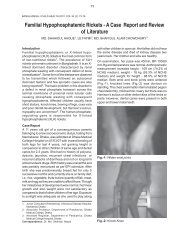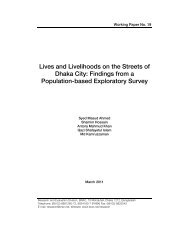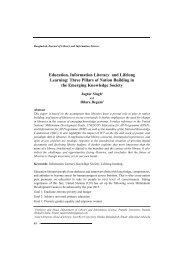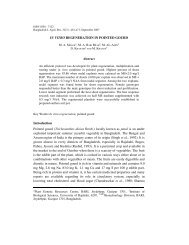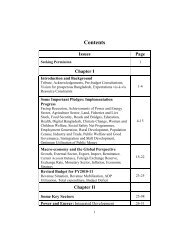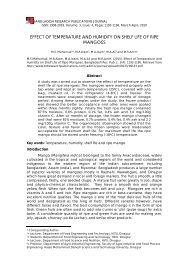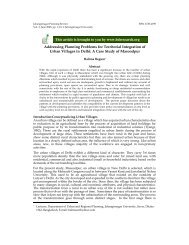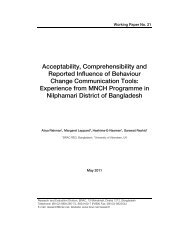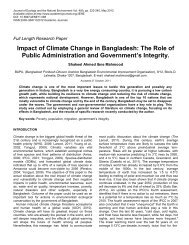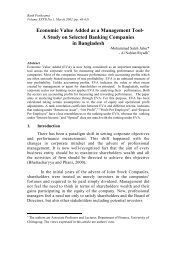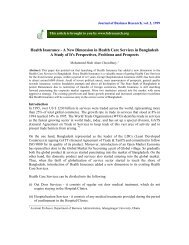Studies on Policy Option for Quality Seed Production and ... - NFPCSP
Studies on Policy Option for Quality Seed Production and ... - NFPCSP
Studies on Policy Option for Quality Seed Production and ... - NFPCSP
Create successful ePaper yourself
Turn your PDF publications into a flip-book with our unique Google optimized e-Paper software.
4.1.25 Drying method used by the rice farmersOn average, 82% of the farmers used to dry rice grain/seed <strong>on</strong> soil (Katcha) floor in all the study areas(Table 4.1.24). The lower percentage of sample farmers used other methods <strong>for</strong> their seed drying likeChatal, Polythene sheet <strong>and</strong> Trepal which are 3, 7 <strong>and</strong> 9%, respectively. Am<strong>on</strong>g the farmers’ categories, thepercentage of small farmers, those who dried rice seed <strong>on</strong> Katcha floor, is the maximum (93%) followed bymedium farmers (80%). On the other h<strong>and</strong>, the user of Chatal, Polythene sheet <strong>and</strong> Trepal occupied thehighest value (14% farmers) by the large farmers followed by medium farmers (10% farmers). The reas<strong>on</strong>sbehind this situati<strong>on</strong> were the high price of these materials, which were hardly af<strong>for</strong>dable in c<strong>on</strong>siderati<strong>on</strong> ofthe farmers’ socio-ec<strong>on</strong>omic c<strong>on</strong>diti<strong>on</strong>.Table 4.1.24 Drying method used by the farmers in the study areasFarmers’category%farmers dry rice grain/seedRajshahi Rangpur Jessore Average (all sites)C P S T C P S T C P S T C P S TLarge 10 5 69 16 5 11 67 17 3 5 84 8 6 7 73 14Medium 4 3 81 12 2 15 71 11 1 6 87 6 2 8 80 10Small 0 3 96 1 0 7 88 5 0 4 95 1 0 5 93 2Average 5 4 82 10 2 11 75 11 1 5 89 5 3 7 82 9Note: C- Chatal, P- Polythene sheet, S-Soil, T-Trepal4.1.26 <strong>Seed</strong>s of rice varieties stored by the farmersThe sample who stored different varieties of rice seed <strong>for</strong> using in the next cropping seas<strong>on</strong> are listed inTable 4.1.25. Am<strong>on</strong>g the Boro rice varieties, BRRI dhan28 was the most popular <strong>on</strong>e in all cases <strong>and</strong>there<strong>for</strong>e, the seed of this variety was kept almost by all the farmers. In Jessore, the farmers preservedthe seeds of Miniket (Indian variety) because; it was another popular variety am<strong>on</strong>g the local farmersdue to its high quality grain <strong>and</strong> high market price. In case of T.aman rice, seeds of Swarna (Indianvariety) <strong>and</strong> BR11 were kept in all the study areas while in Jessore, a small porti<strong>on</strong> of rice seed of othervarieties namely BR10, BRRI dhan30, BRRI dhan31, BRRI dhan32 <strong>and</strong> Ranjit were also kept <strong>for</strong>sowing in the next cropping seas<strong>on</strong>.Table 4.1.25 <strong>Seed</strong>s of rice varieties stored by the farmers in the study areasFarmers’Name of the rice varietiescategoryRajshahi Rangpur JessoreBoro BRRI dhan28, BRRI dhan29 BRRI dhan28, BRRIdhan29Miniket (Indian), GS1, BRRI dhan28T.aman Swarna (Indian), BR 11 Swarna, BR 11 BR 10, BRRIdhan30, 31, 32,Swarna, RanjitT.aus Nayanm<strong>on</strong>i, Parija - -4.1.27 Rice seed storage by the farmersThe average amount of stored seed of Boro <strong>and</strong> T.aman rice was 89 <strong>and</strong> 81kg/farm family, respectively(Table 4.1.26). The large farmers stored comparatively higher amount of rice seed (123 <strong>and</strong> 117 kgBoro <strong>and</strong> T.aman rice seed/farm family) compared to medium <strong>and</strong> small categories of farmers. The35



